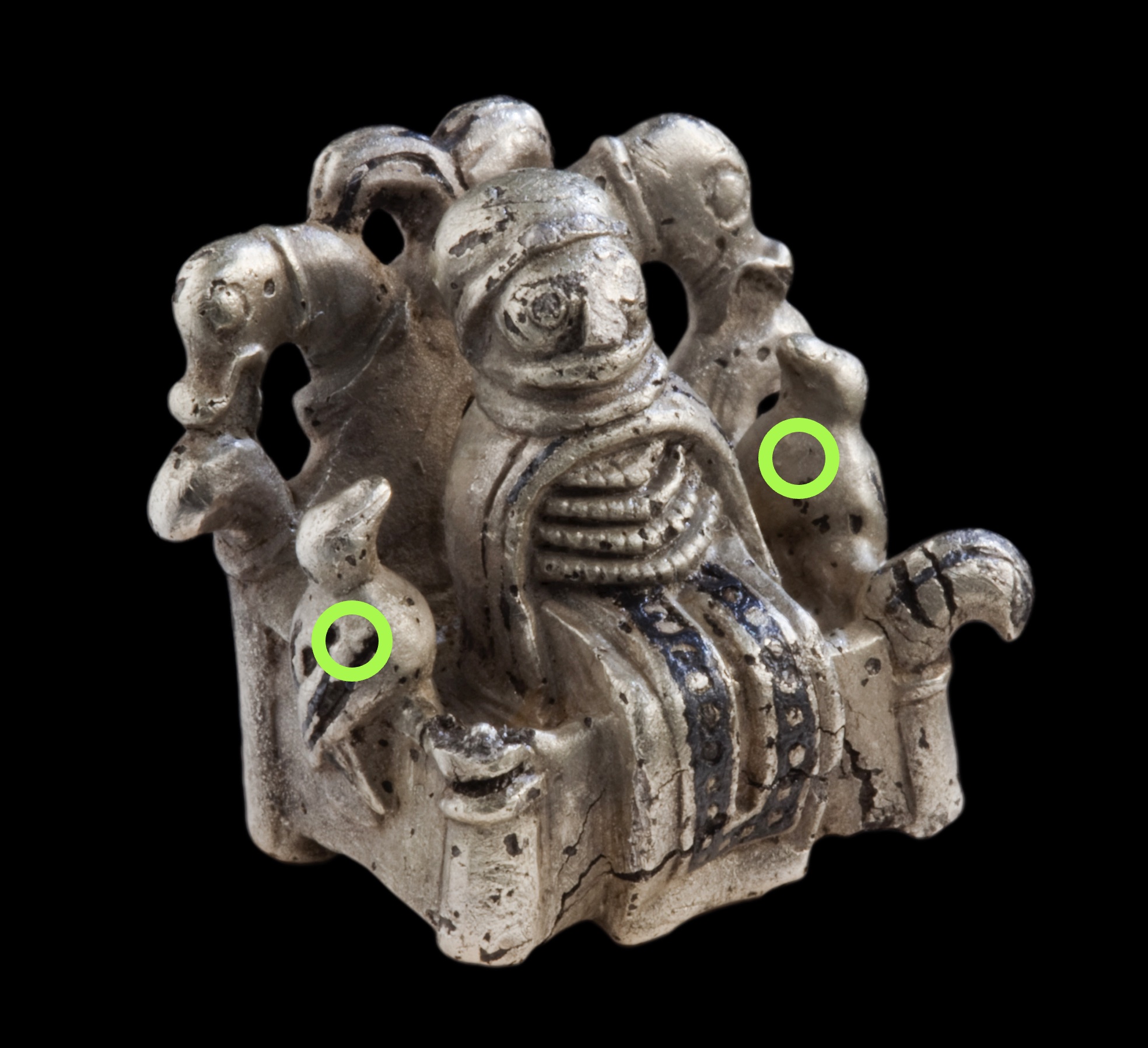Of the many animals depicted in Viking art, birds are arguably one of the most common motifs. The Ljre figure is no exception; arguably its most easily identifiable element are the two birds which perch on the sides of the chair. With their bodies tilted back and heads angled up, they appear to be focused intently on the sitter.

Figure from Lejre, DK.
Silver with niello inlay.
1.8×2.0×1.3 cm.
(source: Wikimedia)
Does the positioning of the birds mean they are sentient? Possibly even capable of communicating with the sitter? Their beaks appear to be closed, so the possibility that they are actively speaking to the sitter seems unlikely. However, the angling of their bodies suggests a degree of movement not present in the rigid stance of the sitter. As fully formed entities, this may suggest that the birds have only landed on the arms of the chair temporarily. If they really are completing some sort of task, the angle at which they are perched may indicate their potential to spring back into flight.
This reading of the birds would most closely align with interpretations that identify the sitter as Odin, and the two birds as his ravens, Huginn and Muninn (Christensen 2014). Interestingly, though, the two birds are described by Christensen as “identical” (p. 68). Even if Huginn and Muninn are described as working as a pair, the two birds are given distinct names: Huginn is understood to mean “Thought” while Muninn is “Memory.” If the birds are meant to be Huginn and Muninn specifically, why are they crafted identically on the Lejre figure? Perhaps interpretations of the birds’ specific jobs as helpers who delivered news to Odin was only an interpretation that was introduced in textual sources, after the creation of this figure.
Regardless of whether the 10th-century maker of the figure would have identified the birds as Huginn and Muninn, the inclusion of two orderly birds on the arm rests of the chair links the sitter to nature. Possibly, suggests that the sitter has some degree of command over the birds. It is also possible, however, that the sitter is intended to be some other specific figure who has been depicted with symbols of wealth and power (like birds that are reminiscent of Odin’s) without actually being a God themself.
It is worth noting that the birds are fully separated from the sitter. For some artifacts with animal motifs, they are not fully separated from human elements. One artifact from Uppåkra, for example, depicts what appears to be a human figure with wings.

Uppåkra Mount
(source: Helmbrecht 2012)
Helmbrecht (2012) argues that the mount depicts Wayland the Smith (as opposed to other gods and giants from Old Norse literature that have also been linked to birds) using a detail on the left wing of the figure: the droplets on the wing link the mount to a specific version of Wayland’s story with which the people of Uppåkra would have been familiar. In a passage about the winged figure from Uppåkra, Graham-Campbell (2021, p. 165) writes about how Loki was described as a shape-shifter in textual sources. It is interesting to think about the potential for anthropomorphic depictions in Viking art, of which the Uppåkra figure is an example.
In addition to showing the range of meanings that birds could indicate with regard to Norse mythology, the debates over who the winged figure from Uppåkra depicts underscores that Odin is not the only figure linked to birds in Norse mythology. Is the fact that there are two similar-looking birds enough to conclude that the Lejre figure depicts Huginn and Muninn specifically? The answer is for you to decide.
Christensen, Tom. 2014. “A silver figurine from Lejre.” Danish Journal of Archaeology 2, no. 1: 65–78.
Graham-Campbell, James. 2021. Viking Art. 3rd ed. World of Art. London: Thames and Hudson.
Helmbrecht, Michaela. 2012. “A Winged Figure From Uppåkra.” Fornvännen 107, no. 3: 171–78.
« Previous | Home | Next »